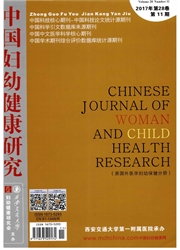

 中文摘要:
中文摘要:
目的针对462名儿童口腔健康知晓状况,探讨口腔卫生习惯及儿童牙病干预措施。方法选择上海市浦东新区某小学一年级至五年级的学生462名,采用自编问卷对小学生口腔健康知识进行调查,并将结果进行统计分析。结果学生9个口腔健康知识问题回答正确率为7.79%(36/462)~94.81%(438/462),其中窝沟封闭的作用知晓率最低,对牙齿有益的食物知晓率最高。刷牙率(刷牙≥1次/d)为96.46%(441/462),每日早、晚均刷牙者占调查人数的44.16%(204/462)。一至三年级小学生每日早晚均刷牙的占调查人数的35.74%,四、五年级占57.06%,差异有统计学意义(X^2=17.36,P=0.00〈0.01)。偶尔刷牙的男、女生分别有10人和1人,差异有统计学意义(X^2=6.01,P=0.01)。小学生获取口腔健康知识的途径主要来自媒体、教师和医护人员。结论该学校小学生对口腔健康知识的了解欠佳。应针对口腔卫生知晓率的薄弱环节,进行健康宣教,培养学生养成良好的口腔卫生习惯。
 英文摘要:
英文摘要:
Objective To understand the oral health knowledge of 462 pupils and to explore oral hygiene habits and related intervention measures. Methods A cluster sample of 462 pupils of grade one to five was ehosen from a primary school in Pudong District. Self-designed questionnaire was given to them on oral health knowledge and the results were analyzed. Results The correct answer rate of the nine questions on oral health knowledge was 7.79% (36/462)-94.81% (438/462). The lowest was the effect of groove closed and the highest was which foods were beneficial to teeth. The teeth brushing rate ( brushing teeth once or more than once a day) was 96.46% (441/462). About 44.16% (204/462) of the surveyed pupils brushed their teeth every morning and evening. There were 35.74% of investigated pupils at grade one to three brushing teeth every morning and evening, and 57.06% at grade four to five. The difference was significant (X^2= 17.36 ,P = 0.00 〈 0.01 ). There were 10 boys and 1 girl brushing teeth occasionally, and the difference was significant (X^2 = 6.01 , P = 0.01 ). The main channels for the pupils to obtain oral health knowledge were media, teachers and medical staff. Conclusion The oral health knowledge of pupils in this primary school is deficient. Health education should be given based on weakness of oral health knowledge awareness, and pupils need to be trained with good oral health habits.
 同期刊论文项目
同期刊论文项目
 同项目期刊论文
同项目期刊论文
 期刊信息
期刊信息
